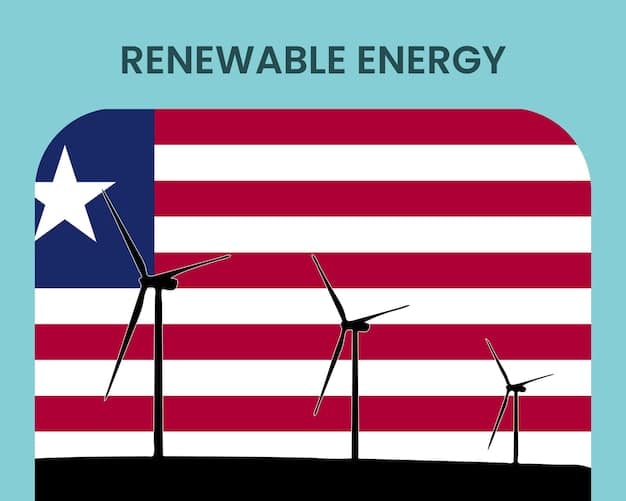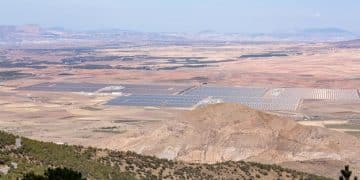Mexico’s Energy Policies: Impact on US Investments Examined

Mexico’s recent energy policy shifts, emphasizing state control and national energy sovereignty, are creating significant uncertainties and potential challenges for existing and future United States investments, particularly in the renewable energy and oil and gas sectors, necessitating careful strategic re-evaluation by American stakeholders.
The intricate relationship between Mexico and the United States, particularly concerning energy, has always been a focal point of economic and geopolitical discussions. As Mexico implements new energy policies, a critical question arises: What are the potential effects of Mexico’s new energy policies on US investments? This exploration delves into the nuances of these policy changes, examining their implications across various sectors and evaluating the landscape for American investors.
Understanding Mexico’s Shifting Energy Landscape
Mexico’s energy sector has undergone significant transformations, particularly with the 2013-2014 energy reforms that opened up the market to private and foreign investment. This period saw a surge in interest from global players, including many from the United States, eager to participate in an economy previously dominated by state-owned enterprises like Petróleos Mexicanos (Pemex) and Comisión Federal de Electricidad (CFE). The reforms aimed to modernize infrastructure, boost production, and introduce competition, promising a more dynamic and efficient energy market. For a time, this vision largely held true, attracting considerable amounts of foreign direct investment, particularly in oil and gas exploration, power generation, and electricity transmission.
A Return to State Control
However, the current administration in Mexico has signaled a distinct shift away from the liberalized market model, emphasizing energy self-sufficiency and the strengthening of state-owned entities. This pivot is largely driven by a nationalist agenda that views energy as a strategic resource to be controlled by the state for the benefit of its citizens. The administration’s rhetoric often highlights perceived past abuses by private companies and the need to reduce reliance on foreign entities. This ideological stance has translated into concrete policy actions, including legislative changes and regulatory adjustments designed to favor Pemex and CFE, often at the expense of private sector participants.
One of the primary mechanisms for this shift has been the prioritization of CFE’s power generation over private renewable or natural gas plants. This happens through dispatch order changes, which dictate which power plants send electricity to the grid first. Historically, the most economic plants were dispatched first, which often included private renewable or efficient natural gas facilities. Under the new policies, CFE’s older, often less efficient, and more polluting plants are given preference, leading to higher electricity costs and reduced opportunities for private power producers.
- Legislative Changes: Amendments to energy laws often aim to reverse or weaken provisions of the 2013-2014 reforms.
- Regulatory Adjustments: New regulations or interpretations of existing ones can create hurdles for private projects.
- Prioritization of State-Owned Entities: Pemex and CFE are given preferential treatment in contracts, permits, and dispatch.
- Emphasis on Self-Sufficiency: Reducing reliance on energy imports and boosting domestic production.
This evolving policy framework demands careful scrutiny from US investors, as it fundamentally alters the risk-reward calculus for projects in Mexico. Understanding the intent behind these shifts, whether ideological or pragmatic, is crucial for anticipating future developments and making informed decisions. The landscape is dynamic, and what might seem like a minor regulatory change can have profound implications for investment viability and profitability.
Key Policy Changes Affecting US Investments
The shift in Mexico’s energy policy is not merely rhetorical; it is underpinned by a series of legislative actions, regulatory changes, and administrative decisions that directly impact the operational environment for foreign investors, particularly those from the United States. These changes signal a clear intention to reassert state control and bolster the position of Pemex and CFE.
Electricity Sector Reforms and Dispatch Order
Perhaps one of the most contentious changes has been the reform of the Electricity Industry Law. This reform aims to give CFE priority in electricity dispatch, regardless of cost or environmental impact. Prior to this, a merit order system favored the cheapest and cleanest power generation, which often included private wind, solar, and natural gas plants. The new priority given to CFE’s often more expensive and carbon-intensive fossil fuel plants directly undermines the business models of private renewable energy projects. Many US companies have invested heavily in wind and solar farms in Mexico, relying on the previous dispatch rules. The change in dispatch order can significantly reduce their revenues by limiting the amount of electricity they can sell to the national grid, making their investments less economically viable.
The implications extend beyond just dispatch. It impacts transmission access, grid interconnection, and overall market stability. Private generators face increased uncertainty regarding connection permits and the availability of transmission capacity, which is also largely controlled by CFE. This creates a challenging environment for expanding or even maintaining existing operations, effectively chilling new investment in the Mexican power sector.
Hydrocarbons Sector: Pemex’s Rejuvenation
In the hydrocarbons sector, the focus has been on strengthening Pemex and reversing what the current administration perceives as detrimental effects of the previous reforms. Policies have been enacted to give Pemex greater control over refining, oil exploration, and production. This includes a more restrictive stance on new private oil and gas contracts or modifications to existing ones. For US companies involved in upstream exploration and production, this translates into fewer opportunities for new ventures and potential re-evaluations of existing shared production agreements.
One notable example is the slowing or halting of bid rounds for new exploration blocks, which were a cornerstone of the 2013-2014 reforms. Additionally, there have been efforts to increase Pemex’s refining capacity, including the controversial Dos Bocas refinery, which has faced cost overruns and delays. While the intent is to achieve energy self-sufficiency, particularly in gasoline and diesel production, these moves can crowd out private investment in midstream and downstream sectors that would otherwise complement the supply chain. US companies involved in fuel distribution, storage, or processing may encounter new regulatory hurdles or increased competition from a state-backed Pemex.

Regulatory Uncertainty and Rule of Law Concerns
Beyond specific legislative changes, a significant concern for US investors is the perceived increase in regulatory uncertainty and the weakening of the rule of law. Arbitrary permit revocations, delays in approvals, and changes to established contracts are increasingly reported. This environment makes it difficult for companies to plan long-term investments, as the regulatory framework appears subject to frequent and unpredictable shifts. Foreign investors rely on a stable and predictable legal framework to protect their assets and ensure a fair return on investment. When the rules of engagement change frequently, or when legal challenges against government decisions face an uphill battle, investor confidence erodes significantly.
- Permit Delays and Revocations: Projects facing unexpected suspensions or cancellations of previously granted permits.
- Contractual Modifications: Government attempts to renegotiate or alter terms of established agreements.
- Judicial Resilience: Challenges in enforcing contractual rights or international arbitration awards.
- Shifting Regulatory Interpretations: Ambiguous or new interpretations of regulations that harm private interests.
These policy changes, individually and cumulatively, pose significant challenges to US investments in Mexico’s energy sector. They reflect a fundamental shift in the government’s approach to energy, prioritizing national control over market liberalization, which directly impacts the profitability and security of foreign capital.
Impact on US Direct Investments: Sector-Specific Analysis
The broad strokes of Mexico’s new energy policies translate into concrete and often disparate impacts across various sectors of US direct investment. Understanding these sector-specific ramifications is crucial for American businesses operating or considering operations south of the border.
Renewable Energy: A Diminished Outlook
The renewable energy sector, once a beacon for foreign investment in Mexico, has arguably borne the brunt of the policy shifts. US companies invested heavily in solar farms and wind power projects, enticed by Mexico’s abundant natural resources and commitment to clean energy targets under previous administrations. However, the prioritization of CFE’s conventional power plants in the dispatch order, coupled with regulatory efforts to limit grid connection for renewables, has severely undermined the economic viability of these projects. Many existing wind and solar farms find themselves generating less revenue as their dispatched energy is curtailed, while new projects face significant hurdles in obtaining necessary permits and interconnection agreements. This has led to a significant slowdown in new renewable energy investments from the US and, in some cases, the abandonment of already planned projects, which represents a substantial loss of potential clean energy capacity and economic growth.
The long-term implications are concerning not only for investors but also for Mexico’s environmental commitments. The shift away from renewables could impact Mexico’s ability to meet its climate change targets, potentially leading to international criticism and economic penalties in the future. For US investors, the once-promising market for sustainable energy initiatives has become fraught with regulatory and financial risk.
Oil and Gas: Increased State Dominance
In the oil and gas sector, US investments primarily span upstream exploration and production, midstream infrastructure (pipelines, storage), and downstream refining and distribution. The current administration’s focus on bolstering Pemex and achieving energy self-sufficiency has directly translated into reduced opportunities for private US firms in exploration and production. Bid rounds for new oil and gas blocks have effectively ceased, and existing contracts may face increased scrutiny or subtle pressures. While existing contracts are generally respected, the lack of new opportunities limits growth potential for US exploration and production companies.
In the midstream and downstream segments, US companies involved in pipeline operation or fuel distribution may face heightened competition from Pemex, which is receiving significant state support to expand its infrastructure and market share. Regulatory delays for import permits or new facility approvals also add to operational challenges. Some US companies that had invested in gas pipelines, relying on the growth of the Mexican industrial sector and thermal generation, find their investments less utilized due to the CFE’s preference for its own fuel sources or delays in connecting new power plants. While outright expropriation is rare, the creation of an uneven playing field and increased bureaucratic hurdles can effectively diminish the profitability and attractiveness of these investments.
Energy Infrastructure: Bottlenecks and Delays
US companies have also made substantial investments in energy infrastructure, including natural gas pipelines, power transmission lines, and storage facilities, critical components for integrating and distributing energy across Mexico. These investments often serve both the private sector and state-owned entities. However, regulatory delays, permit revocations, and disputes over land rights have plagued several infrastructure projects. For example, some natural gas pipelines built by US firms have faced delays in operation due to local opposition or government-imposed restrictions, leading to significant financial losses for investors. The uncertainty surrounding future infrastructure development, particularly projects that are not directly aligned with CFE or Pemex’s immediate priorities, makes it a high-risk area for new US capital.
- Natural Gas Pipelines: Many US companies invested in these, anticipating significant demand; delays in CFE converting plants or local disputes have reduced revenue.
- Electricity Transmission: Expansion and upgrades, once areas for private participation, are now largely reserved for CFE, limiting lucrative opportunities.
- Fuel Storage and Terminals: Private projects face increased competition and regulatory hurdles from Pemex’s renewed focus on domestic control of supply chains.
The cumulative effect of these sector-specific impacts is a marked reluctance among US investors to commit new capital to Mexico’s energy sector. Existing investments face challenges in profitability and expansion, while the pipeline for future projects appears increasingly constrained. This situation has led to calls from US industry groups for greater clarity and adherence to free-market principles, highlighting the growing tension between national interests and foreign investment expectations.
US Diplomatic and Business Responses
The significant shifts in Mexico’s energy policies have not gone unnoticed in Washington D.C. and among the American business community. The US government and various industry groups have expressed growing concerns, highlighting the potential negative ramifications for bilateral trade relations and investor confidence. The response has been multi-faceted, ranging from formal diplomatic grievances to strategic legal considerations by affected businesses.
Official US Concerns and Trade Implications
The US government, through diplomatic channels, has consistently raised concerns regarding Mexico’s energy policies. These concerns often center on the potential violations of the United States-Mexico-Canada Agreement (USMCA), particularly provisions related to fair treatment of investors, non-discriminatory practices, and state-owned enterprises. US officials argue that the policies favoring Pemex and CFE create an unfair playing field for private, including US, companies, contravening the spirit and letter of the trade agreement.
High-level discussions between officials from both countries have frequently addressed these issues, with the US emphasizing the importance of predictable regulatory frameworks and adherence to rule of law to maintain investor confidence. The potential for invoking USMCA dispute resolution mechanisms has been alluded to, particularly if the issues are not resolved through direct dialogue. While the US government aims to avoid a full-blown trade dispute, the escalating nature of Mexico’s energy nationalism could force stricter measures. The implications extend beyond the energy sector, potentially chilling overall US investment in Mexico if the perceived risks of policy unpredictability become too high.
Industry Advocacy and Legal Challenges
American energy companies and industry associations, such as the American Chamber of Commerce of Mexico (AmCham Mexico) and various renewable energy coalitions, have been vocal in their opposition to the policy changes. They have actively engaged with both the Mexican and US governments to advocate for stronger protections for existing investments and a more level playing field for future projects. These groups often highlight the negative economic consequences of the policies, including job losses, reduced investment, and higher energy costs for Mexican consumers and businesses.
For many US companies, legal recourse remains a viable, albeit challenging, option. Several firms have initiated or are considering arbitration proceedings under various international investment treaties, including the USMCA’s investor-state dispute settlement (ISDS) mechanism. These cases often allege that Mexico’s policy changes constitute indirect expropriation or a breach of fair and equitable treatment clauses. While arbitration can be a lengthy and costly process, it represents a last resort for companies seeking to protect their substantial investments. The outcomes of these legal challenges will be closely watched, as they could set precedents for future investor protections in Mexico and other countries.
- Formal Diplomatic Complaints: The US State Department and Trade Representative have lodged official protests.
- USMCA Concerns: Accusations of non-compliance with investment and state-owned enterprise provisions.
- Industry Lobbies: US trade associations actively campaigning for policy reversal or mitigation.
- Arbitration Proceedings: Companies initiating ISDS claims under bilateral treaties or USMCA for breaches of investment protections.
The diplomatic and business responses underscore the gravity of the situation. While dialogue is preferred, the increasing frustration among US stakeholders may lead to more confrontational measures, potentially impacting the broader bilateral relationship. The resolution of these energy policy disputes will be a critical test of the USMCA and the future of foreign investment in Mexico.
Future Outlook and Strategic Considerations for US Investors
Navigating the complex and evolving energy landscape in Mexico requires a nuanced strategic approach from US investors. The immediate outlook suggests continued challenges, but opportunities may still exist for those willing to adapt and manage elevated risks. The long-term trajectory will largely depend on Mexico’s future political and economic priorities.
Anticipating Continued Challenges
Given the current administration’s steadfast commitment to its energy policies, US investors should anticipate continued hurdles. The emphasis on bolstering state-owned enterprises, particularly Pemex and CFE, is unlikely to reverse course significantly in the near term. This means that private sector, especially foreign, participation may remain limited in key areas like new hydrocarbon exploration and significant power generation projects, particularly renewables, if they compete directly with CFE’s assets. Regulatory uncertainty is also likely to persist, making long-term planning difficult and increasing the cost of doing business.
Furthermore, the broader geopolitical climate and the upcoming Mexican presidential election in 2024 will play a crucial role. A change in administration could potentially bring a shift in policy, offering some hope for a more market-friendly environment. However, any new government would still face the challenge of unwinding deeply entrenched policies and possibly managing fiscal constraints related to the state-owned energy companies. Investors should therefore monitor political developments closely, understanding that significant policy reversals are rare and often gradual.
Potential Areas for Engagement and Niche Opportunities
Despite the challenges, not all doors are closed to US investment. Niche opportunities may emerge in areas that complement, rather than directly compete with, Pemex and CFE’s strategies. For instance, in midstream activities, US companies could find opportunities in specialized services, technology provision, or infrastructure improvements that Pemex may need but lacks the internal expertise or capital to develop efficiently. Similarly, in the electricity sector, demand for smart grid technologies, energy storage solutions, or distributed generation (e.g., rooftop solar for industrial consumers) might present avenues for investment, especially if independent of the main national grid.
Another area of potential engagement could be through partnerships with Mexican companies. Local partnerships can help navigate the regulatory environment, understand the cultural nuances, and sometimes offer a buffer against protectionist policies. For US companies, this might mean taking on a less direct ownership role but still benefiting from the market. Furthermore, sustainability and environmental, social, and governance (ESG) factors are increasingly important globally. Investments that can genuinely contribute to Mexico’s environmental goals while fitting within the new policy framework, perhaps by improving efficiency in existing state-owned infrastructure, might gain more traction.

Risk Mitigation Strategies
For US investors committed to the Mexican market, several risk mitigation strategies are paramount. Diversification of investments across different sectors and geographies within Mexico can help spread risk. Careful due diligence, including thorough legal and regulatory reviews, is more critical than ever. Strong contractual protections, wherever possible, and a clear understanding of potential arbitration routes are also essential. Engaging local legal counsel with deep expertise in Mexican energy law and international arbitration is prudent.
- Thorough Due Diligence: Evaluate regulatory risks, policy stability, and contractual enforceability more rigorously.
- Local Partnerships: Collaborate with Mexican firms to navigate political and regulatory landscapes.
- Niche and Complementary Investments: Focus on areas that support rather than compete with state entities.
- Legal Protections: Understand and utilize international investment treaties and arbitration mechanisms.
- Political Risk Insurance: Explore options like OPIC or MIGA insurance to cover political risks such as expropriation.
In conclusion, the path forward for US investments in Mexico’s energy sector is complex and challenging. While direct confrontation through trade disputes or legal battles remains an option, a more pragmatic approach for many companies will involve adapting to the new realities, exploring niche opportunities, and meticulously managing risks. The future of US investment in Mexico’s energy sector will ultimately depend on both the evolution of Mexican policy and the strategic flexibility of American enterprises.
Long-Term Implications for US-Mexico Relations
The ongoing shifts in Mexico’s energy policy have implications that extend far beyond the immediate financial impacts on US companies. They are reshaping the broader economic and political relationship between the two neighboring countries. Understanding these long-term ramifications is essential for both governments and businesses.
Erosion of Trust and Investment Climate
One of the most significant long-term consequences is the potential erosion of trust and confidence in Mexico as a reliable destination for foreign investment. When policy predictability diminishes, and the rule of law appears compromised, it sends a chilling signal to international investors across all sectors, not just energy. US companies contemplating new ventures in Mexico will naturally factor in the experiences of those in the energy sector, weighing the heightened risks against potential returns. This ‘spillover effect’ could deter investments in crucial areas like manufacturing, technology, and services, sectors where Mexico has traditionally attracted significant US capital due to its proximity and favorable trade agreements.
A sustained period of regulatory uncertainty and perceived state intervention could lead to Mexico being viewed as a higher-risk market, potentially diverting foreign direct investment to other countries with more stable and transparent regulatory environments. This would undermine Mexico’s efforts to boost economic growth and create jobs, ultimately impacting its development trajectory.
Impact on Bilateral Trade and Regional Integration
The energy sector is intrinsically linked to broader economic activity. Mexico’s energy policies, by potentially increasing electricity costs or affecting the reliability of energy supply, could impact the competitiveness of manufacturing and other industries that rely on stable and affordable energy. This, in turn, could affect the integrated supply chains that have been meticulously built between the US and Mexico under agreements like the USMCA.
If US firms find it increasingly difficult or costly to operate in Mexico due to energy policies, it could lead to a reconsideration of current production strategies and a potential shift of manufacturing capabilities elsewhere. This would weaken the collaborative framework of regional integration that the USMCA aims to foster. While the USMCA provides mechanisms for dispute resolution, frequent reliance on these mechanisms could strain the overall relationship, diverting focus from other critical areas of cooperation like security, migration, and environmental protection.
Geopolitical Alignment and Energy Security
From a geopolitical perspective, the energy policies also touch upon the broader issue of energy security for North America. The US has long viewed Mexico as a vital partner in ensuring regional energy stability, benefiting from Mexican oil exports and being a key supplier of natural gas to Mexico. Policies that lead Mexico to become more insular in its energy production or that disrupt the flow of energy across the border could have strategic implications for regional energy security.
While Mexico’s desire for energy sovereignty is understandable, a nationalist approach that alienates private and foreign capital, particularly from its largest trading partner, could unintentionally create new vulnerabilities or undermine the benefits of interdependence. Maintaining a constructive dialogue and finding common ground on energy policy will be crucial for nurturing a resilient and mutually beneficial relationship in the long term, ensuring that energy remains a bridge, not a barrier, between the two nations.
- Investment Deterrence: Negative perception extending beyond the energy sector, affecting overall FDI.
- Supply Chain Disruption: Increased energy costs or unreliability could impact US companies manufacturing in Mexico.
- Trade Agreement Strain: Frequent disputes over USMCA provisions could weaken the agreement’s effectiveness.
- Regional Energy Security: Reduced collaboration could impact North American energy independence and stability goals.
The long-term implications underscore the need for a balanced approach from both Mexico and the US. Mexico’s economic growth is intertwined with foreign investment, and alienating its largest source of capital could have significant drawbacks. For the US, maintaining a stable and prosperous Mexico is a strategic imperative. Collaborative solutions that respect Mexico’s sovereign needs while upholding international investment norms will be key to navigating these complex waters.
Navigating the Regulatory Labyrinth: A Guide for Investors
The current energy policy environment in Mexico presents a complex tapestry of regulations, intended and unintended barriers, and shifting interpretations. For any US investor looking to enter or remain in this market, understanding and navigating this “regulatory labyrinth” is paramount. It requires more than just legal compliance; it demands strategic foresight and a proactive approach.
The Challenge of Evolving Regulations
One of the primary challenges stems from the fluidity of the regulatory landscape. Laws are being amended, and new regulations are being introduced, often with short notice or without exhaustive public consultation. This creates a state of perpetual uncertainty for investors. What might be perfectly compliant today could face new restrictions or requirements tomorrow. For instance, changes to environmental permits, grid connection standards, or even labor laws can impact project viability, necessitating constant monitoring and adaptation.
Moreover, the interpretation and enforcement of existing regulations can also shift. Government agencies, influenced by political directives, might apply rules more stringently or delay approvals for private sector projects, particularly those that do not align with the nationalistic energy agenda. This lack of consistency makes it difficult for businesses to predict outcomes, increasing both operational costs and the risk of disputes.
Strategies for Proactive Compliance and Risk Mitigation
Given this scenario, a robust strategy for managing regulatory risk is crucial. The first step involves rigorous due diligence before any new investment or expansion. This goes beyond standard financial and market analysis to include a deep dive into the current and anticipated regulatory framework, discussions with legal experts specializing in Mexican energy law, and assessments of the political appetite for specific types of private investment.
Engagement with local stakeholders and government entities is also vital. Building strong relationships with relevant ministries, regulators, and even local communities can provide early warnings of potential policy shifts and create channels for dialogue. While direct lobbying can be challenging, participation in industry associations or expert forums can help pool resources and present a unified voice for private sector concerns. Understanding the local context, including social, environmental, and political sensitivities, can help mitigate risks from community opposition or unexpected regulatory pushback.
- Continuous Regulatory Monitoring: Stay abreast of all proposed and enacted legislative and regulatory changes.
- Specialized Legal Counsel: Engage Mexican legal experts with deep knowledge of energy sector nuances and regulatory trends.
- Stakeholder Engagement: Foster relationships with government officials, regulators, and local communities.
- Scenario Planning: Develop contingency plans for various policy outcomes, including delayed permits or unfavorable regulatory changes.
Finally, for existing investments, exploring available legal protections, such as those embedded in the USMCA or bilateral investment treaties, is a critical component of risk mitigation. While arbitration is a last resort, positioning a project from the outset to benefit from such protections can provide leverage and a clear recourse mechanism if significant adverse actions occur. This strategic approach to navigating the regulatory labyrinth is not merely about avoiding pitfalls but about proactively shaping a resilient investment strategy in a challenging yet significant market.
Renewable Energy vs. Fossil Fuels: A Clash of Ideologies
At the heart of Mexico’s new energy policies lies a fundamental ideological conflict: the prioritization of fossil fuels, particularly oil and coal, over renewable energy sources. This clash extends beyond mere economic considerations, touching upon national sovereignty, energy independence, and the role of state enterprises in the country’s development trajectory. For US investors, understanding this ideological divide is crucial as it shapes the very ecosystem of energy projects.
The Government’s Stance on Fossil Fuels and Energy Security
The current Mexican administration views the strengthening of state-owned oil company Pemex and electricity utility CFE as central to achieving energy sovereignty. Within this framework, fossil fuels—especially oil and natural gas, and even coal for power generation—are seen as fundamental pillars. The belief is that by controlling and boosting the production of these traditional energy sources, Mexico can reduce its reliance on foreign imports of refined products and electricity, thereby enhancing its national security and economic independence. The construction of the Dos Bocas refinery and the prioritization of CFE’s older, often carbon-intensive, power plants exemplify this commitment.
This perspective often frames past energy reforms, which opened the market to private and renewable energy investors, as detrimental to national interests or as a “sell-off” of strategic assets. Consequently, policies are shaped to favor the financial and operational health of Pemex and CFE, often at the expense of private sector renewable projects. This includes ensuring Pemex has priority access to refining capacity and pipelines, and that CFE’s power plants are dispatched first, even if they are more costly or environmentally damaging than private alternatives.
The Diminished Role of Renewables and Environmental Concerns
Conversely, renewable energy projects, despite their potential for clean energy generation and lower long-term operating costs, have seen their development significantly hampered. From the government’s perspective, large-scale private renewable projects are often seen as part of the “neoliberal” agenda that eroded state control. Regulatory mechanisms, such as increased scrutiny, delays in permitting, and changes to transmission access rules, have made it increasingly difficult and uneconomical for private wind and solar farms to operate or expand. This stance not only impacts US investments in this burgeoning sector but also raises significant environmental concerns, both domestically and internationally. Mexico’s commitment to its climate change targets, particularly under the Paris Agreement, appears increasingly at odds with current energy policies. The emphasis on fossil fuels could lead to higher greenhouse gas emissions and a slower transition to a sustainable energy matrix. For US investors with a strong focus on ESG criteria, this ideological clash presents a clear dilemma. Investing in Mexican fossil fuel projects might contradict corporate sustainability goals, while renewable projects face an uphill battle against strong governmental headwinds. The ideological divide underscores the deeply ingrained nature of current policy decisions, making rapid shifts unlikely without a significant change in political leadership or a fundamental re-evaluation of national priorities.
| Key Insight | Brief Description |
|---|---|
| 🔄 Policy Shift | Mexico is moving towards greater state control in energy, reducing private sector influence. |
| 💸 Investment Impact | US investments, especially in renewables, face reduced profitability and increased uncertainty. |
| ⚖️ Legal Challenges | US companies are exploring or initiating arbitration under USMCA due to policy changes. |
| 🌍 Future Outlook | Challenges persist, but niche opportunities and partnerships might offer avenues for US investors. |
Frequently Asked Questions
▼
Mexico’s policy shifts prioritize state-owned CFE’s fossil fuel plants in electricity dispatch, significantly impacting US renewable energy projects. These changes can reduce the amount of electricity private solar and wind farms can sell, making them less profitable and stalling new investments. Obtaining permits and grid interconnection also faces increased hurdles, creating a challenging environment for renewable energy expansion.
▼
Yes, the oil and gas sector is also affected. Mexico’s focus on strengthening state-owned Pemex limits new exploration and production opportunities for US firms. While existing contracts are generally respected, the lack of new bid rounds and increased competition from a state-backed Pemex in midstream and downstream activities create a challenging environment for growth and profitability for US investors in this sector.
▼
Mexico’s current administration champions energy self-sufficiency and strengthening state control over vital resources. The rationale is largely ideological, aiming to reverse perceived “privatization” of past reforms and ensure energy security benefits directly the nation. This approach seeks to reduce reliance on foreign entities and bolster national companies like Pemex and CFE for strategic and economic independence.
▼
Yes, US investors can and some have explored legal recourse. Many companies are considering or have initiated international arbitration under treaties like the USMCA’s investor-state dispute settlement (ISDS) mechanism. These legal challenges often allege breaches of investment protections, such as indirect expropriation or un-fair treatment. The outcomes of these cases could set important precedents for investor rights in Mexico.
▼
The energy policy shifts can strain US-Mexico relations by eroding investor trust and potentially violating USMCA provisions. This could deter future US investment in various Mexican sectors and impact integrated supply chains. While diplomatic dialogue continues, escalating disputes could weaken bilateral cooperation beyond energy, affecting trade, security, and migration relations, posing long-term challenges for the diplomatic bonds.
Conclusion
The reorientation of Mexico’s energy policies towards greater state control presents a formidable, yet not insurmountable, challenge for US investments. While the landscape is marked by heightened regulatory uncertainty and a clear ideological preference for state-owned entities, proactive engagement, strategic adaptation, and a deep understanding of the evolving dynamics will be crucial for American investors navigating this complex terrain. The long-term trajectory of US-Mexico economic relations in the energy sector will undoubtedly hinge on the ability of both nations to find a pragmatic balance between national sovereignty and the principles of open markets and fair competition.





